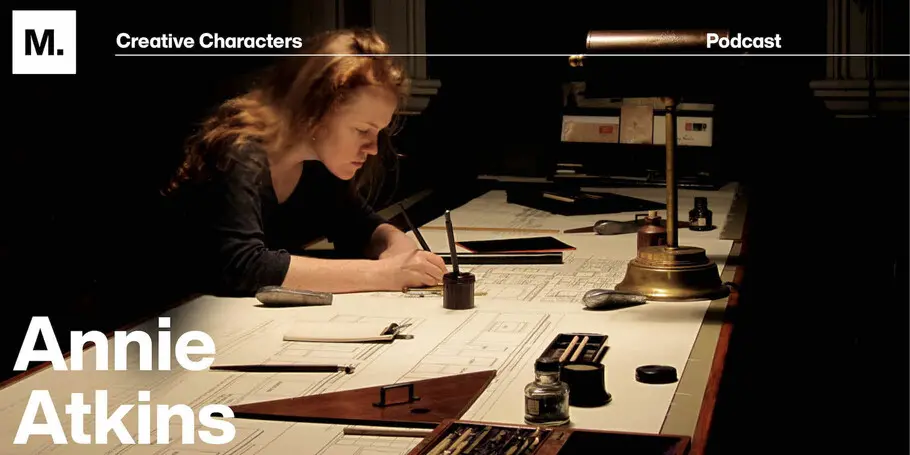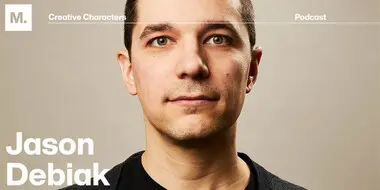Creative Characters S2 E15: Annie Atkins: building worlds in film through graphic props and typography.

Annie Atkins.
This week we’re continuing on with the film theme. Today we’re welcoming Annie Atkins, a creative in the film industry (just like our last guest, Holly Fraser). She’s known for her graphic props and set pieces for Wes Anderson’s Grand Budapest Hotel and Isle of Dogs. She’s also done design work for The Tudors, The Boxtrolls, and Spielberg’s thriller, Bridge of Spies. Tune-in to learn about the magic of film.
Behind the scenes.
Annie has always been immersed in the art and design world, and the transition from commercial graphic design to film graphic design was a unique challenge. After earning her Master’s in Film Production from University College Dublin, Annie got her first taste of the entertainment industry while working on Showtime’s series The Tudors.
“I was really thrown in at the deep end because my first job, I was the only graphic designer on that show…I kind of had to figure out a lot of it for myself. And I was also working to a period that I had no experience in.”
Annie worked as a graphic designer on the set of The Tudors for several years, honing her design skills, before transitioning to the world of film.

Lights, camera, action.
The process of working alongside a crew where everyone had a specialized job to do, and seeing the filmmaking process come to life energized Annie.
“Even watching stage hands carry a throne across the car park was so exciting. It was so thrilling to see like people on walkie talkies radioing between departments. The fact that I was going to need a little tool belt to carry my tools with me in case I needed to nip down to the set and fix a little bit of stained glass that I’d made or something.”
A magical moment for Annie is being able to sit down in the cinema and see how every department’s hard work comes to life.
“In the cinema it’s so immersive; everything comes together and you’re just that right there in the heart of the story. I like to think that part of that is because in the art departments, we take care of these tiny, tiny little details that maybe help nudge actors a little bit further into character, help nudge the audience a little bit further into the story.”
The hero movie.
When looking back at her body of work, the design project that stands out to Annie is working on graphic props for Wes Anderson’s film, Grand Budapest Hotel. Otherwise known as her hero movie. “I feel like I’m going to be talking about that film when I’m 90.”
What made the experience so special was how Anderson sheds a light on graphic design in his filmmaking. “He very much makes a character out of the graphic design.”
What goes into a prop.
The process of making a prop is a bit more nuanced than you might think. For Annie, prop making includes a deep dive into the history of the film period, sourcing materials, and then actually making and customizing the prop to fit the film. She’s made a range of props over the course of her career from candy bars to royal scrolls.
A common prop among films is newspapers, which often feature the names of the film crew.
“Often what we do is we take names from our crew list because if we take names from the crew list, we have legal clearance to use them in our props. It’s just a funny thing. So, if you watch a movie and you see somebody’s name on a prop, you usually also see that name in the credit list at the end of the movie.”
When she’s not creating in her studio, Annie teaches workshops on an intro to the film industry. Students think of a character and they start designing props for that character to represent the world they live in. She hopes to expand her courses to include a 2-day portfolio review workshop in the future.
“I absolutely love it because they come to visit me here in Dublin and we spend two days together and they really breathe life back into everything for me again.”
The golden gates of Hollywood.
It’s impossible to talk about the film industry without also acknowledging its challenges, which include the lack of diversity and the barrier to entry. That being said, since working on Grand Budapest Hotel, Annie has seen a real cultural shift in the growing presence of TV shows, which she thinks has helped improve diversity in the industry.
“I’m convinced that it’s television that has made so many more interesting roles for female characters because they have to write like 12 hours of screen time. Whereas a movie you can get away with writing a movie an hour and a half of screen time and making it all about the guys. But all of a sudden, you’re you, you’re filling 12 hours, you’re going to need some complex female characters to make those stories work.” Perhaps the biggest challenge to working in the industry though, is getting past the golden gates.
That being said, Annie believes the best way to get to know people in the film industry is to introduce yourself with a valuable body of work. She truly believes that there is room in the industry for everyone, including newcomers that don’t have connections. Your body of work is more valuable, she says.
“We’re always looking for good people in the art department… We need all the help we can get. If you approach us with a portfolio of work that shows that you have a real interest in designing and cutting, and sticking and folding, and making all these props and thinking around the story, and thinking around the scripts, and thinking about the period and the genre, you’re going to get in.”


















